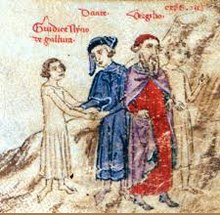Nino Visconti
| Nino [Ugolino] Visconti | |||||
|---|---|---|---|---|---|
 Judge Nino Visconti with Dante Alighieri and Virgil | |||||
| Judge/King of Gallura | |||||
| Reign | 1275-1296 | ||||
| Predecessor | John | ||||
| Successor | Joanna | ||||
| Born | 1265 Pisa | ||||
| Died | August 1296 (aged 30–31) Gallura, Sardinia | ||||
| Spouse | Beatrice d'Este | ||||
| Issue | Joanna, Queen of Gallura | ||||
| |||||
| House | Visconti (Sardinia branch) | ||||
| Father | John, King of Gallura | ||||
| Mother | [Chiara?] della Gherardesca | ||||
Ugolino Visconti (died 1296), better known as Nino, was the
Nino succeeded his father in Gallura in 1275 or 1276 and spent most of his life alternating time in Pisa and Gallura. His chaplain, a friar named Gomita, was caught taking bribes to release prisoners and so Nino had him hanged.[2] Gomita was placed in the eighth circle of Hell in the Inferno. Nino was commended for his act of justice and piety.
In 1288, he began to share power with his grandfather in Pisa, but the two quarreled. The elder Ugolino tried to enlist the archbishop Ruggieri degli Ubaldini to expel Nino from the city, but the archbishop instead exiled them both and appointed his own podestà and capitano del popolo. Then a Pisan army was sent to take control of Nino's giudicato. The betrayed giudice never set foot in his giudicato again. However, after his exile, Nino Visconti counterattacked Pisa with Genoa, Lucca and the Florentine Guelfs.[3]
In 1293, peace was made and Nino later died in Sardinia.
Role in Dante's Divine Comedy
Dante Alighieri was a friend to Nino Visconti. According to historians, they may have become friendly with each other when Nino lived out part of his exile in Florence.[3] Nino was also the cousin of Moroello Malaspina, with whom Dante was on good terms.[3]
Nino appears in Dante's Divine Comedy. In the eighth canto of Purgatorio, to his mild surprise, Dante meets Nino in the region of Purgatory outside St. Peter's gate.[2] This area was devoted to the souls of those who neglected their spiritual welfare for the sake of their country. Here they are detained for a period equal to their earthly lifetimes, before beginning their purgation.[2]
When they meet, Dante describes his journey, and that he is not actually dead.
Critical Reception of Dante's Nino Visconti
There have been many investigations into the importance of Nino Visconti in Dante's work. Some critics claim that Nino represents the independence and peace of mind characteristic of Purgatorio, which serves as a contrast from Inferno.[4] This is because Dante makes Nino appear so sure of his path. There have also been connections drawn between Nino and Forese Donati, who appears later on. Both have similar conversations about the women in their life, and both foster a close bond to Dante. Although Nino speaks harshly of his wife, this is justified by Dante, as Dante deems his cause worthy enough.[4] Again there is the notion of him being "truthful" as the "Noble Judge"—he is exposing the truth of his life to Dante. However, Dante emphasizes that Nino is only explaining God's righteous decisions for Beatrice and that he only cares for God's judgement of her acts.[3]
Nino's family is also interpreted as bearing a symbolic significance. Many commentators agree that Nino's daughter and wife may represent a
Nino Visconti in Other Works
Nino was also an acquaintance of several
The cobla which appears immediately after it in the chansonnier is also addressed to Nino but has not been assigned by any scholar to Paolo. Terramagnino da Pisa, a native of Pisa's peninsular territories, was frequently present in Gallura, where he probably spent most of his adult life. His Doctrina de Cort was addressed to Nino, at whose court it may have been written. Another Occitan poet with whom Nino had contact was Luchetto Gattilusio. Gattilusio acquired property interests in Sardinia and appeared in several documents pertaining to Nino's rule.
References
Further reading
- Michele Tamponi. Nino Visconti di Gallura: il dantesco «giudice Nin gentil» tra Pisa e Sardegna, guelfi e ghibellini, faide cittadine e lotte isolane. Viella, 2010.
